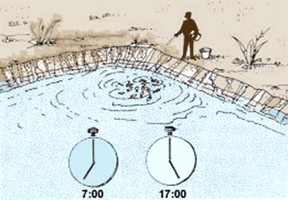11. TAKING CARE OF YOUR FISH
(280) Take very good care of your fish. Keep the water green and feed the fish regularly. While feeding, watch them carefully to see that they are healthy and swimming strongly.
FEEDING YOUR GROWING FISH
(281) You have already learned that the big fish in your pond will get much of their food from small plants and animals that grow in the green water.
(282) To keep the water green, fertilize your pond each week. If you are using plant compost or plant material, keep the crib filled to the water line. If you are using animal compost or manure, see items 216 to 219.
(283) To make your fish grow more quickly you must also feed them other kinds of food. You can feed them
|
|
|
(296) Mark each place by making a square or a ring of light wood or bamboo. Drive a pole into the pond bottom and attach the square or ring, as shown in the drawing. |
(297) When you feed the fish, put the food inside the square or ring. You may be able to see any uneaten food on the bottom under the square or ring. If you cannot see the bottom, feel with your hands to find any uneaten food that may be there. |
|
|
|
|
PROVIDING GOOD WATER FOR YOUR FISH(298) If you find any dead fish floating in your pond, take them out right away. Change some of the water in your pond. (299) To change some of the water in the pond, open the inlet and let in some new clean water. The old water will drain out of the pond at the overflow. Do this for 2 or 3 hours each day for several days until you see that your fish are well. (300) If the weather is too hot, if you feed your fish too much or if you use too much fertilizer, there may be too little oxygen in the water for your fish to breathe. |
|
| (301) If you see your fish coming to the surface gasping for air, give them less food and do not use any fertilizer for several weeks. | ||
|
(302) Put more oxygen into the water of your pond by changing some of the water for several days, as you did in item 299. |
(303) When you let new water into the pond, let it in quickly so that it will come with a splash and bring more air into the water. |
|
|
|
|
|
|
(304) If you see any other things wrong with your fish that you do not understand, stop feeding them and stop using fertilizer. Then change some of the water in your pond every day for several days, as you did in item 299. |
(305) After several days if your fish are still not well, if they are not eating well, are gasping for air or are not swimming strongly, ask your extension agent or your fish culture station for help. |
Summary
YOU HAVE LEARNED HOW TO TAKE CARE OF YOUR GROWING FISH
Fertilize the water once a week to keep it green:
- if you use compost, add about 10 kg per 100 m2
- if you use animal manure, add per 100 m2 one of the following:
- 2 to 3 kg of chicken droppings
- 8 to 10 kg of pig manure
- 10 to 15 kg of cow manure - if you use plant wastes only, keep the fertilizing crib full
- pack this material tightly in each crib
Feed your fish once a day with local by-products and wastes:
- feed early in the morning or late in the afternoon, when it is cool
- it is best to do it at the same time each day
- feed at the same place and mark it
- regularly check for left-over food and adjust food ration accordingly
Check that your fish keep healthy:
- they should swim strongly in mid-water
- they should eat actively when you feed them
- if they don't eat well, and especially if they stay at the water surface
gasping for air
- quickly add some new water to the pond
- stop fertilizing for a week
- stop feeding for a few days until your fish look healthy again






